How Long Does Crab Last in the Fridge
Your fresh crab storage duration depends on whether it's raw or cooked. Fresh whole raw crab lasts 1-2 days in the fridge when stored at 32°F to 40°F, while cooked crab meat stays fresh for 3-5 days. You'll need to store your crab in an airtight container or wrap it tightly in plastic wrap, ideally placing it in the coldest part of your fridge. For raw crab, cook it within 24 hours for best freshness, and always check for signs of spoilage like strong odors, discoloration, or slimy texture before consuming. Proper storage techniques can greatly extend your crab's shelf life and maintain its quality longer.
This post may contain affiliate links. If you make a purchase through these links, I may earn a commission at no additional cost to you. Additionally, portions of this post may be generated using artificial intelligence (AI) technology. While we strive for accuracy, please be aware that AI-generated content may not always be perfect and should be fact-checked when necessary.
The Spatula Scoops
- Fresh whole crab stays fresh for 1-2 days when stored properly in the refrigerator at or below 40°F (4°C).
- Cooked crab meat remains fresh for 3-5 days when stored in an airtight container or wrapped tightly in plastic wrap.
- Live crabs can be stored for 1-2 days in the fridge, but must be kept moist without being submerged in water.
- Raw cleaned crab lasts 3-4 days in sealed storage, while raw whole crab stays fresh for 1-2 days.
- Store crab in the coldest part of the fridge (32-40°F), wrapped tightly in plastic with no air pockets.
Safe Storage Temperature Guidelines
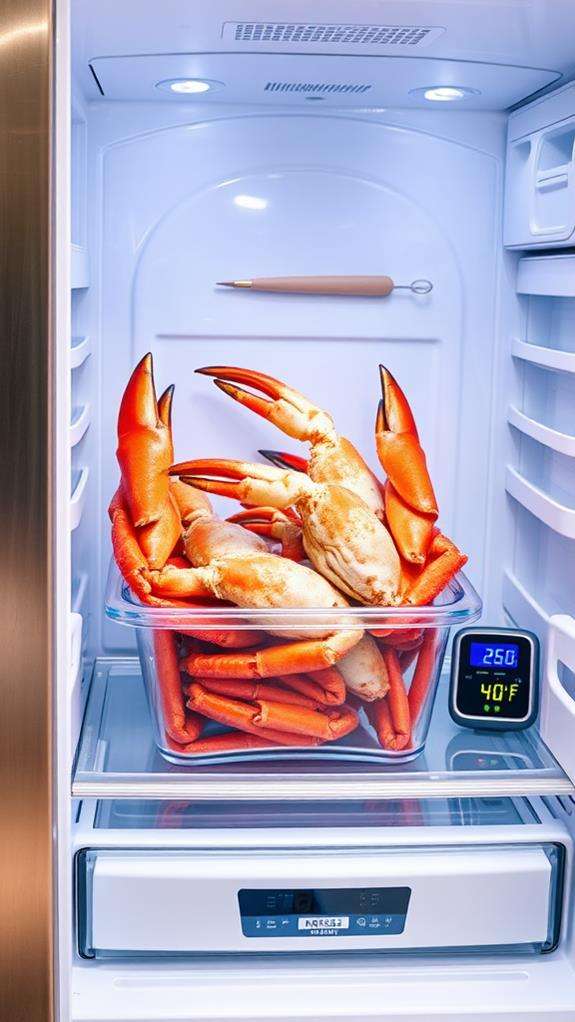
Keeping crab at the right temperature is essential for food safety. Your refrigerator should maintain a consistent temperature between 32°F and 40°F (0°C to 4°C), with 37°F (2.8°C) being the ideal sweet spot for storing fresh crab. You'll want to use a refrigerator thermometer to monitor these temperatures regularly, as your fridge's built-in dial settings aren't always accurate.
When you're storing fresh crab, place it in the coldest part of your refrigerator, which is typically at the back of the bottom shelf. Don't store it in the door compartments, where temperatures fluctuate each time you open the fridge. You should keep your crab in an airtight container or wrapped tightly in plastic wrap, then placed in a bowl of ice for maximum freshness. If there's any cooked crab juice or melted ice, drain it away promptly to prevent bacterial growth.
For best safety, you'll need to get your fresh crab into the refrigerator within two hours of purchase or cooking – or within one hour if the ambient temperature is above 90°F (32°C).
Fresh Whole Crab Storage
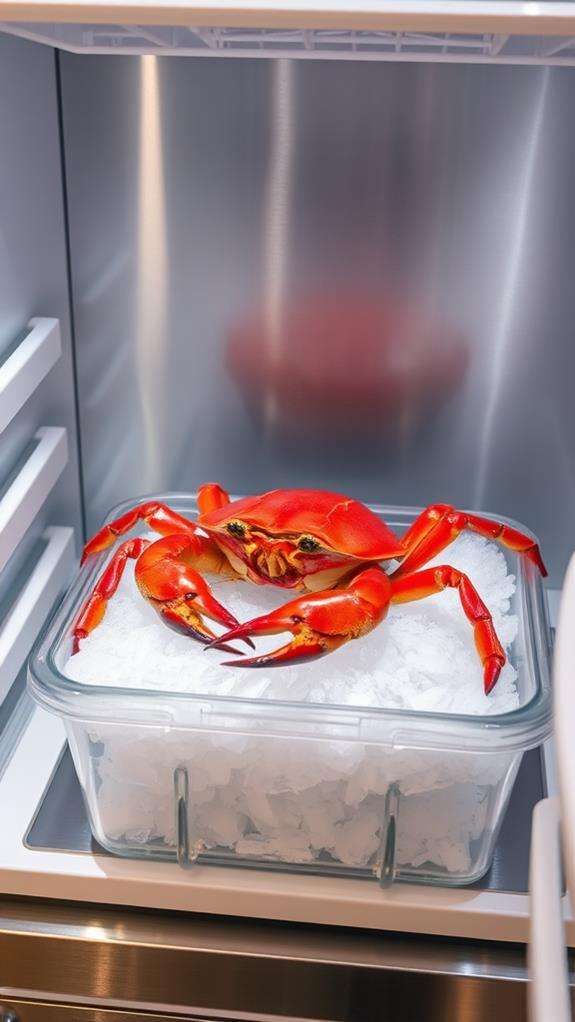
Your raw, whole crab will stay fresh for only 1-2 days when stored properly in the refrigerator at 40°F (4°C) or below. To maximize freshness, you'll want to wrap your crab tightly in plastic wrap or aluminum foil, or place it in an airtight container with a damp paper towel to maintain moisture. If you're storing multiple crabs, layer them carefully with damp paper towels between each one, and place them toward the back of your refrigerator where the temperature remains most consistent.
Raw Storage Time Limits
Fresh whole crab requires careful attention to storage time, as it spoils quickly even when refrigerated. When you're storing raw crab, you'll need to follow strict time limits to guarantee food safety and maintain quality. Keep your raw crab at 40°F or below in your refrigerator's coldest section.
| Storage Type | Maximum Time | Safety Notes |
|---|---|---|
| Live Crab | 1-2 days | Keep moist, don't submerge |
| Raw, cleaned | 3-4 days | Store in sealed container |
| Raw, whole | 1-2 days | Wrap tightly in plastic |
You'll want to check your raw crab regularly for signs of spoilage. If you detect any strong, ammonia-like odors or notice the meat becoming slimy or discolored, it's time to discard it. The shell should maintain its original color without any dark spots or unusual discoloration. For peak freshness, you should cook your raw crab within 24 hours of purchase, especially if it's been previously frozen and thawed. Remember that these timeframes assume consistent refrigeration at the proper temperature and minimal exposure to air and light.
Proper Wrapping Techniques
To lock in freshness, proper wrapping of whole crab requires multiple protective layers and careful attention to detail. You'll want to create an airtight seal that prevents both moisture loss and cross-contamination while preserving the crab's delicate texture and flavor profile.
Start your wrapping process with these essential steps:
- Pat the crab's exterior dry with paper towels, ensuring you've removed any excess moisture that could promote bacterial growth
- Wrap the crab tightly in plastic wrap, making sure there aren't any air pockets or loose sections that could compromise freshness
- Add a second layer of protection using heavy-duty aluminum foil, which helps maintain consistent temperature and prevents freezer burn
- Place the wrapped crab in a sealed plastic storage bag, squeezing out as much air as possible before closing
If you're dealing with multiple crabs, wrap each one individually to prevent them from sticking together. Don't forget to label each package with the date of storage using a permanent marker. This wrapping method creates multiple moisture barriers while allowing you to easily access your seafood when needed.
Storing Cooked Crab Meat
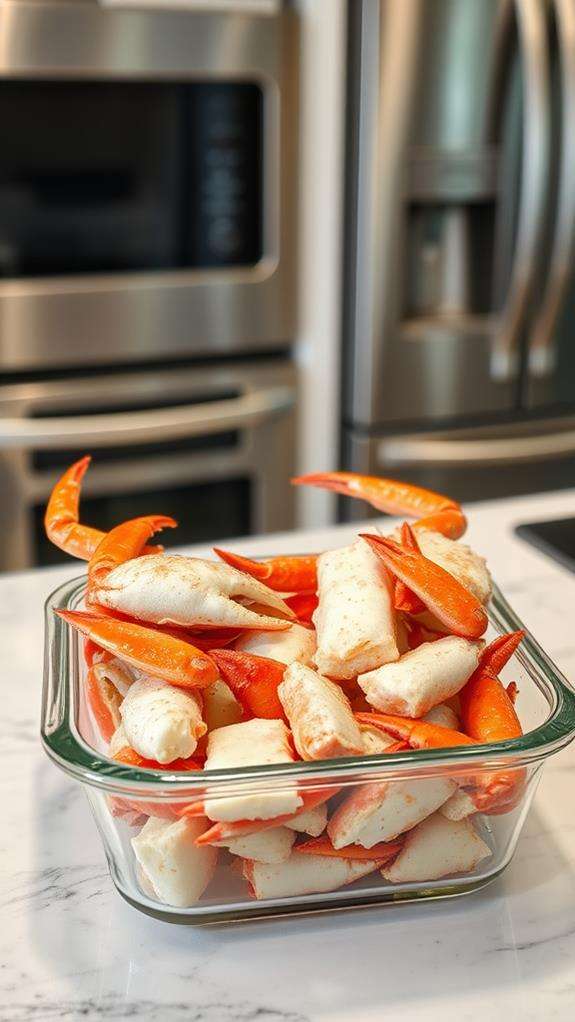
Properly stored cooked crab meat will stay fresh in your refrigerator for 3-5 days. You'll want to store it in an airtight container or wrap it tightly in heavy-duty aluminum foil or plastic wrap to maintain its quality. Make sure you refrigerate the crab meat within two hours of cooking, or within one hour if the ambient temperature is above 90°F.
When you're storing your cooked crab meat, place it in the coldest part of your refrigerator, typically at the back, where the temperature remains most consistent. You'll need to keep the temperature at or below 40°F to prevent bacterial growth. If you've purchased pre-cooked crab meat from the store, check the "best by" date and follow any specific storage instructions on the package.
Don't leave your cooked crab meat at room temperature for extended periods, as this can lead to rapid bacterial growth. If you notice any signs of spoilage, such as a sour smell, slimy texture, or discoloration, it's best to discard the crab immediately. For longer storage periods, you should consider freezing your cooked crab meat instead of refrigerating it.
Signs of Spoiled Crab
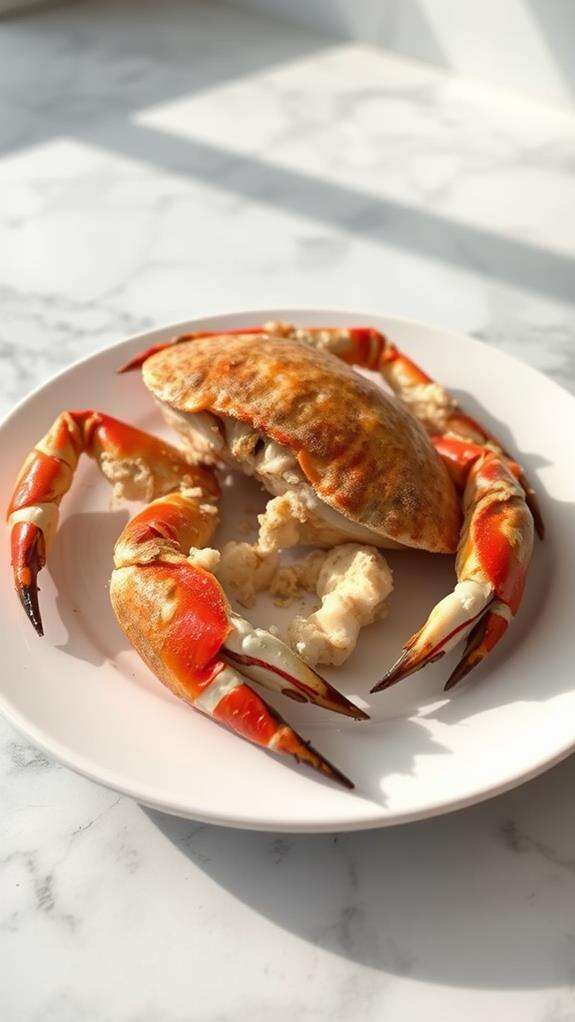
When checking if your crab has spoiled, you'll want to look for obvious visual signs first, including any discoloration from the meat's natural white or pinkish hue to brown, gray, or yellow tones, as well as any fuzzy spots that could indicate mold growth. A strong, unpleasant fishy odor or ammonia-like smell is one of the most reliable indicators that your crab has gone bad, as fresh crab should have only a light, briny scent of the ocean. You should also watch for any slimy texture on the meat's surface, which, combined with the other warning signs, means it's time to discard the crab immediately.
Visual Signs To Check
Looking out for visual cues can help you quickly identify spoiled crab before consuming it. When you're examining your stored crab meat, pay close attention to any discoloration or changes in texture that might indicate deterioration. The meat should maintain its natural color, whether that's white, pinkish, or brown, depending on the crab species.
- Check for any fuzzy or moldy spots on the meat's surface, which often appear as blue, green, or white patches and indicate bacterial growth
- Look for a yellowing or graying of the meat, as fresh crab meat should never appear dull or have a brownish tinge
- Examine the meat's texture – it shouldn't appear slimy, mushy, or have a cottage cheese-like consistency
- Inspect for any dark spots or discoloration that weren't present when you first stored the crab
If you notice any shell pieces still attached to the meat, they shouldn't show signs of darkening or deterioration. You'll want to assess the entire portion of crab meat thoroughly, as spoilage can begin in one area and spread throughout the container.
Detecting Bad Smells
The smell test stands out as one of the most reliable ways to determine if crab has spoiled. When you're checking your refrigerated crab, you'll want to take note of any unusual or off-putting odors that differ from fresh crab's clean, oceanic scent.
Fresh crab should have a mild, slightly sweet seafood aroma that reminds you of the ocean. If you notice any sour, acidic, or ammonia-like smells, your crab has likely gone bad. The ammonia odor is particularly concerning, as it's a clear indicator of protein decomposition. You'll also want to watch out for any fishy, rancid, or chemical-like scents that weren't present when you first stored the crab.
Don't confuse the natural briny smell of crab with spoilage. If you're unsure, take a second opinion from someone else in your household, as our noses can sometimes become desensitized to certain odors. When detecting these smells, it's important to check both the meat and the shell, if present, as decomposition can affect different parts of the crab at varying rates. If there's any doubt about the smell, it's better to err on the side of caution and discard the crab.
Freezing Crab for Longevity
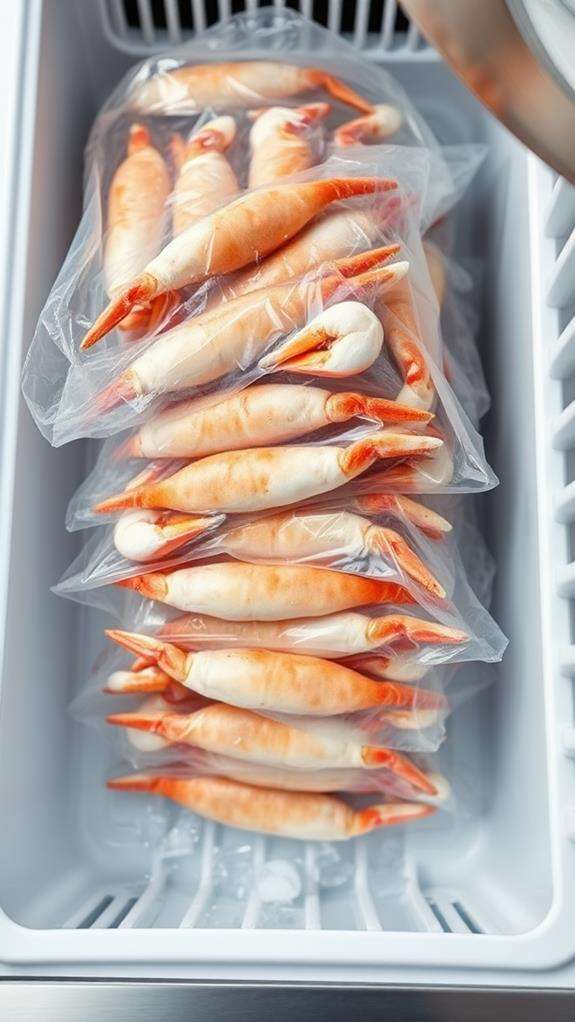
For considerably extending your crab's shelf life, freezing offers the best solution. When properly frozen, your crab meat can last up to six months while maintaining its quality and nutritional value. You'll need to prepare the crab correctly before freezing to guarantee the best results and prevent freezer burn.
To freeze your crab effectively, follow these essential steps:
- Clean and cook the crab thoroughly, ensuring it's completely cooled before freezing
- Remove the meat from the shell and place it in freezer-safe containers or heavy-duty freezer bags
- Push out as much air as possible from the containers to prevent crystallization
- Label each container with the date of freezing and type of crab meat
When you're ready to use your frozen crab, transfer it to your refrigerator and let it thaw gradually for 24-48 hours. Don't thaw it at room temperature, as this can promote bacterial growth. If you're in a hurry, you can place the sealed container in cold water, but you'll need to use the meat immediately after thawing. Remember that once thawed, frozen crab won't maintain its quality if refrozen.
Thawing Frozen Crab Properly

Proper thawing of frozen crab plays an essential role in preserving its taste, texture, and safety for consumption. You'll want to follow specific methods to guarantee you're thawing your crab correctly and safely.
The safest way to thaw frozen crab is to place it in your refrigerator overnight, allowing approximately 24 hours for every 2 pounds of crab. You'll need to keep the crab in its original packaging or place it in a sealed container to prevent cross-contamination with other foods. If you're short on time, you can use the cold water method. Simply submerge the sealed crab in cold tap water, changing the water every 30 minutes until it's completely thawed.
Never thaw crab at room temperature or use hot water, as these methods can promote bacterial growth and compromise food safety. You'll also want to avoid using your microwave to thaw crab, as this can lead to uneven thawing and partially cooked spots. Once your crab is thawed, you should cook it within 24 hours and never refreeze previously frozen crab that's been thawed.
Best Containers for Crab Storage

Selecting appropriate storage containers for crab significantly impacts its freshness and shelf life. When you're storing crab in your refrigerator, you'll want to choose containers that maintain ideal moisture levels while preventing cross-contamination with other foods.
The most effective storage solutions for keeping your crab fresh include:
- Airtight glass containers with snap-locking lids, which prevent moisture loss and block odors from affecting other foods
- Food-grade plastic containers with hermetic seals, offering excellent temperature stability and stack-ability
- Vacuum-sealed bags, which remove excess air and maximize shelf life while minimizing freezer burn
- Perforated seafood storage containers, allowing proper ventilation for live crabs while maintaining humidity
You'll want to avoid using standard zip-top bags or aluminum foil, as they don't provide adequate protection against temperature fluctuations and moisture loss. If you're storing picked crab meat, verify your container has a tight-fitting lid and place it in the coldest part of your refrigerator, typically at the back. For best results, place the container on a bed of ice, changing it daily to maintain freshness and prevent bacterial growth.
Extending Crab Shelf Life
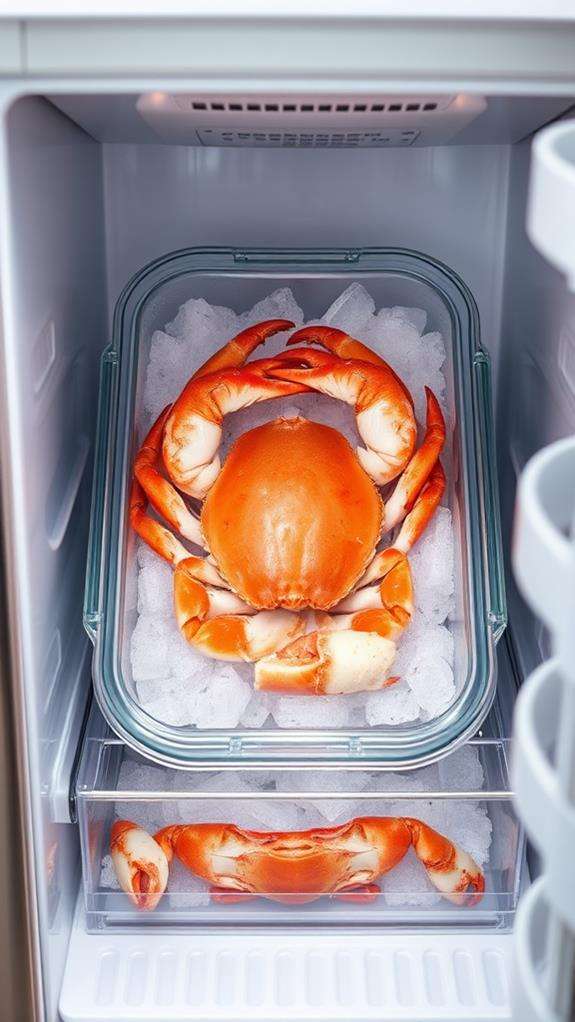
Beyond choosing the right storage container, several practical steps can maximize your crab's refrigerator life. You'll want to implement these preservation techniques immediately after purchase or cooking to maintain ideal freshness.
Here's a thorough breakdown of shelf-life extension methods and their impacts:
| Method | Expected Impact |
|---|---|
| Ice Packing | Maintains 32-38°F temperature zone |
| Paper Towel Lining | Absorbs excess moisture |
| Vacuum Sealing | Removes oxygen exposure |
| Temperature Monitoring | Prevents bacterial growth |
| Regular Inspection | Identifies spoilage early |
You can further extend your crab's shelf life by placing it in the coldest part of your refrigerator, typically the back bottom shelf. Don't store it near strong-smelling foods, as crab meat readily absorbs odors. If you're storing live crabs, you'll need to keep them moist but not submerged, using damp newspaper or seaweed to maintain humidity.
For cooked crab meat, you should remove it from the shell before storing, as this reduces bacterial growth points. Remember to date-label your storage container and consume the crab within the recommended timeframe, which varies depending on whether it's live, cooked, or pasteurized.
Frequently Asked Questions
Can I Keep Crab Legs in the Fridge if They're Still Attached?
Yes, you can store crab legs in the fridge while they're still attached, but you'll want to keep them in an airtight container or wrap them tightly in plastic wrap. If they're raw, you should cook them within 24 hours. If they're already cooked, you've got 3-5 days to enjoy them. Make sure you're storing them at 40°F or below, and you'll notice a change in smell if they've gone bad.
Does Adding Lemon Juice Help Preserve Fresh Crab Meat Longer?
While adding lemon juice might seem like a good preservation method, it won't greatly extend your crab meat's shelf life. The citric acid can actually start breaking down the meat's proteins over time. You're better off storing your fresh crab meat in an airtight container, keeping it as cold as possible (32-34°F), and using it within 3-5 days. If you want to add lemon, it's best to do so just before serving.
Should I Rinse Crab Meat Before Storing It in the Refrigerator?
You shouldn't rinse already-cleaned crab meat before refrigerating it, as excess moisture can promote bacterial growth and reduce its shelf life. If you've just cooked whole crabs, you'll want to clean them first, but pre-picked crab meat from the store is ready to store. Simply pat the meat dry with paper towels if it seems too wet, then place it in an airtight container before refrigerating.
Can I Store Different Types of Crab Meat Together in One Container?
While you can technically store different types of crab meat together, it's not recommended. Each variety has its own delicate flavor profile and moisture content, which can affect other types when stored together. You'll want to keep them separate to maintain their distinct tastes and textures. Additionally, if one portion spoils, it won't contaminate the others. Store each type in its own airtight container for the best results.
Does Reheating Refrigerated Crab Multiple Times Affect Its Storage Life?
You shouldn't reheat crab meat multiple times, as each reheating cycle notably reduces its safety and storage life. When you reheat crab, you're creating temperature fluctuations that encourage bacterial growth and protein breakdown. If you've already reheated your crab once, it's best to consume it immediately or discard it. To maximize freshness, only reheat the portion you'll eat immediately and keep the rest refrigerated.





